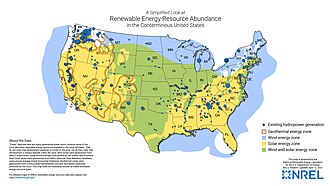
Renewable energy sources in 2022. Renewables were 8.4% of total energy, or 8.3 quads.[1]
Renewable electricity sources in 2022. Renewables were 21% of total electricity, or 907 TWh.[2]
| Part of a series on |
| Renewable energy |
|---|
 |
According to data from the US Energy Information Administration, renewable energy accounted for 8.4% of total primary energy production[1] and 21% of total utility-scale electricity generation in the United States in 2022.[3]
Since 2019, wind power has been the largest producer of renewable electricity in the country. Wind power generated 434 terawatt-hours of electricity in 2022, which accounted for 10% of the nation's electricity and 48% of renewable generation.[2] By January 2023, the United States nameplate generating capacity for wind power was 141.3 gigawatts (GW).[4] Texas remained firmly established as the leader in wind power deployment, followed by Iowa and Oklahoma as of the first quarter of 2023.[5]
Hydroelectric power is the second-largest producer of renewable electricity in the country, generating around 6.2% of the nation's electricity in 2022 as well as 29% of renewable generation.[2] The United States is the fourth largest producer of hydroelectricity in the world after China, Canada and Brazil.
Solar power provides a growing share of electricity in the country, with over 111.6 GW of installed capacity generating about 3.4% of the country's total electricity supply in 2022, up from 2.8% the previous year. As of 2020, more than 260,000 people worked in the solar industry and 43 states deployed net metering, where energy utilities bought back excess power generated by solar arrays.[6][7] Large photovoltaic power plants in the United States include Mount Signal Solar (600 MW) and Solar Star (579 MW). Since the United States pioneered solar thermal power technology in the 1980s with Solar One, several more such power stations have been built. The largest of these solar thermal power stations are the Ivanpah Solar Power Facility (392 MW), southwest of Las Vegas, and the SEGS group of plants in the Mojave Desert, with a total generating capacity of 354 MW.[8]
Other renewable energy sources include geothermal, with The Geysers in Northern California the largest geothermal complex in the world.
The development of renewable energy and energy efficiency marked "a new era of energy exploration" in the United States, according to former President Barack Obama.[9] In a joint address to the Congress on February 24, 2009, President Obama called for doubling renewable energy within the following three years. Renewable energy reached a major milestone in the first quarter of 2011, when it contributed 11.7% of total national energy production (660 TWh), surpassing energy production from nuclear power (620 TWh)[10] for the first time since 1997.[11] In his 2012 State of the Union address, President Barack Obama restated his commitment to renewable energy and mentioned the long-standing Interior Department commitment to permit 10 GW of renewable energy projects on public land in 2012.[12] Under President Joe Biden, Congress increased that goal to 25 GW by 2025.[13] As of May 2023, the Bureau of Land Management has approved projects meeting approximately 37% of that goal.[14]
- ^ a b "Primary Energy Production by Source" (PDF). EIA. February 3, 2024.
- ^ a b c "Electric Power Monthly". EIA.
- ^ "Electricity Net Generation: Total (All Sectiors)" (PDF). EIA. January 29, 2024. Retrieved February 3, 2024.
- ^ "ACP Clean Power Quarterly Report Q3 2021" (PDF). cleanpower.org. American Clean Power Association. Archived from the original (PDF) on November 29, 2021. Retrieved November 29, 2021.
- ^ "U.S. Installed and Potential Wind Power Capacity and Generation". WINDExchange. United States Department of Energy. Retrieved November 29, 2021.
- ^ Editorial Board (April 26, 2014). "The Koch Attack on Solar Energy". New York Times.
- ^ "National Solar Jobs Census". The Solar Foundation.
- ^ "SEGS I, II, III, IV, V, VI, VII, VIII & IX". fplenergy.com. Archived from the original on August 5, 2014.
- ^ "President Obama Touts Clean Energy on Earth Day". Archived from the original on April 29, 2009.
- ^ Ron Pernick and Clint Wilder (2012). "Clean Tech Nation" (PDF). p. 5.
- ^ "Total Energy". US Energy Information Administration.
- ^ – via Wikisource.
- ^ 43 U.S.C. § 3004
- ^ Grandoni, Dino (May 9, 2023). "Biden's energy goals run up against painful WWII legacy". The Washington Post. pp. A3.